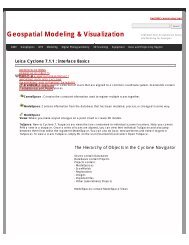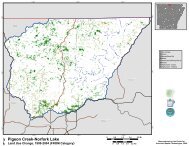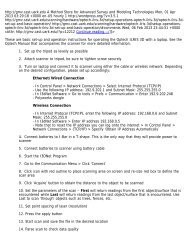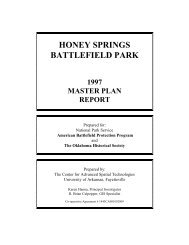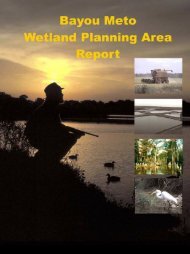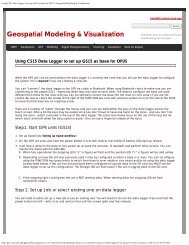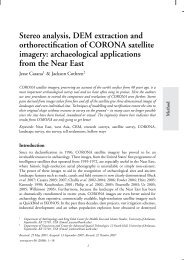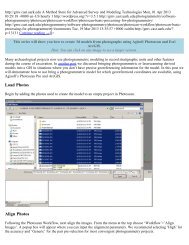Louisiana Oil and Gas Laws and Regulations - CAST
Louisiana Oil and Gas Laws and Regulations - CAST
Louisiana Oil and Gas Laws and Regulations - CAST
Create successful ePaper yourself
Turn your PDF publications into a flip-book with our unique Google optimized e-Paper software.
primarily by the Fish <strong>and</strong> Wildlife Service <strong>and</strong> also by the National Marine Fisheries Service, forcertain marine creatures. Dwindling species are listed as either endangered or threatenedaccording to assessments of the risk of their extinction. An endangered species is defined as"any species which is in danger of extinction throughout all or a significant portion of itsrange...." A threatened species is as "any species which is likely to become an endangeredspecies within the foreseeable future throughout all or a significant portion of its range." TheSecretary of the Interior decides to list the species based on the "best available" scientific <strong>and</strong>commercial information, after a series of procedural steps to ensure public participation. Oncea creature is listed as endangered or threatened, its "taking" is prohibited under 16 U.S.C. §1538. To "take," under the ESA, means "to harass, harm, pursue, hunt, shoot, wound, kill, trap,capture, or collect, or to attempt to engage in any such conduct." After a species is listed asthreatened or endangered, the Secretary of the Interior must also designate critical habitat,which is either where the species is found or, if it is not found there, where there are featuresessential to its conservation. Once the habitat is identified, special protections are put into placefor the area as well as the creature.Federal <strong>Regulations</strong> <strong>and</strong> OrdersU.S. Army Corps of Engineers Clean Water Act <strong>Regulations</strong>, 33 C.F.R. §§ 320; 323-338The U.S. Army Corps of Engineers shares authority under the Clean Water Act along with theEnvironmental Protection Agency. This section of regulations governs what responsibilities theCorps has along with the policies <strong>and</strong> procedures that they use.Department of the Interior Minerals Management, 43 C.F.R. §§ 3000-3873.3The United States Government is the largest l<strong>and</strong>owner in the country <strong>and</strong> controls about 30%of the l<strong>and</strong>. In Arkansas, the federal government has significant holdings in the western half ofthe state including some l<strong>and</strong> in the Fayetteville Shale. The Department of the Interior managesthe mineral issues that arise throughout the country on federal l<strong>and</strong> <strong>and</strong> these regulationsgovern how the federal government will deal with the various parties in the exploration, leasing,drilling, <strong>and</strong> recovery of minerals on federal l<strong>and</strong>s.Environmental Protection Agency<strong>Oil</strong> <strong>and</strong> <strong>Gas</strong> Extraction Point Source Category, 40 C.F.R. §§ 435.10-435.70These EPA regulations <strong>and</strong> guidelines concerning the use of technology <strong>and</strong> technologicalrequirements were introduced to reduce the impact of oil <strong>and</strong> gas wells on the surroundingenvironment.Clean Air Act <strong>Regulations</strong>, 40 C.F.R. §§ 1-99The purpose of the Clean Air Act is to protect human health <strong>and</strong> the environment fromemissions that pollute ambient, or outdoor, air. The Clean Air Act establishes the authority ofthe EPA to create regulations <strong>and</strong> procedures to carry out this goal. These regulations work with<strong>and</strong> supplement the CAA by setting out exactly the procedures, thresholds, reportingrequirements, <strong>and</strong> minimum compliance st<strong>and</strong>ards for air quality.Water Programs <strong>Regulations</strong>, 40 C.F.R. §§ 100-149The Water Programs <strong>Regulations</strong> are administered EPA with the intended goal of protectingwater quality by regulating the discharge of pollutants, including oil <strong>and</strong> gas, establishingguidelines to test water quality, enforcing national drinking water regulations, administer theUnderground Injection Control (UIC) Program, <strong>and</strong> set state st<strong>and</strong>ards for their UIC programs.Superfund, Emergency Planning <strong>and</strong> Community Right-to-Know Programs <strong>Regulations</strong>,40 C.F.R. §§ 300-374



